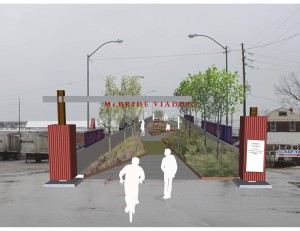On Saturday, January 25 at 3PM, CIVITAS is hosting a 40-‐minute presentation (with architect Adam Trott, landscape architect Michael Beightol, urban critic Stephen Sonnenberg and social sculptor Lisa Austin) on their proposal to re-‐purpose the McBride Viaduct into an urban park and pedestrian transit route. Free and open to the public, the presentation will be held six blocks North of the Viaduct at Poet’s Hall, 1136 East Lake Road, Erie, PA.
Named for a beloved pastor, the McBride Viaduct was built, in part, to allow “safe passage” for children walking from their homes South of the tracks to their school a few blocks North. Closed to vehicular traffic since 2010 (due to stability concerns) the 1,170 foot long Viaduct still provides a vital service as a pedestrian and bike bridge connecting East 12th and East 19th Streets over the busy CSX and Norfolk Southern rail tracks.
Since the construction of the Viaduct almost eighty years ago, contemporary infrastructure work has carved up and isolated some neighborhoods, inadvertently harming the Eastside. While logistically sound, the plans to divert pedestrians from the Viaduct to the utilitarian Eastbay Connector overlook the unpleasantness of a daily walk along a busy highway lined with sound barriers instead of enjoying a stroll on sidewalks of neighborhood streets and a human-‐scaled viaduct.
To maintain the Viaduct’s critical link in the city’s fabric, the volunteer team has created a proposal for an inviting Viaduct Park with rest areas featuring the structure’s expansive views of church steeples, commercial spaces and industry. Architect Adam Trott warns that “demolition will erase these compelling views, turn our back on our industrial heritage and waste the embodied energy of the materials and labor that went into constructing the Viaduct.”
During the January 25th presentation, site plans and drawings will be presented. If the community supports the proposal to re-‐purpose the Viaduct, the immediate goal will be to gain the ear of elected leaders and Penn DOT administrators. The structure must be immediately stabilized, water drainage must be improved, and lights and security cameras must be installed. Two landscaped entrances will be established.
Additional plans to complete the Viaduct park will evolve organically as businesses and neighborhoods linked to the Viaduct become involved in the project. Organizations including neighborhood businesses, churches and watch groups, the Lake Erie Regional Conservancy, the Erie Art Museum, Bike Erie, Voices for Independence, Penn State Master Gardeners and the Society for Industrial Archeology are potential partners in this project.
 The Viaduct is an opportunity that Erie cannot afford to waste. In addition to protecting pedestrians and connecting neighborhoods, Adam Trott says “a re-‐purposed Viaduct will finally give something back to residents of the Eastside.” Rather than spending an estimated 1.2 million in taxpayer money for demolition, Stephen Sonnenberg notes that if those funds were used to create a park, “the investment could help spark revitalization along Erie’s historic East Avenue corridor.” Michael Beightol commented, “this 1940-‐era structure is appropriate to the scale of the neighborhood and can become a regional destination.” And Lisa Austin noted “around the world, larger industrial sites once viewed as eyesores have become a source of pride and economic development.” Examples include:
The Viaduct is an opportunity that Erie cannot afford to waste. In addition to protecting pedestrians and connecting neighborhoods, Adam Trott says “a re-‐purposed Viaduct will finally give something back to residents of the Eastside.” Rather than spending an estimated 1.2 million in taxpayer money for demolition, Stephen Sonnenberg notes that if those funds were used to create a park, “the investment could help spark revitalization along Erie’s historic East Avenue corridor.” Michael Beightol commented, “this 1940-‐era structure is appropriate to the scale of the neighborhood and can become a regional destination.” And Lisa Austin noted “around the world, larger industrial sites once viewed as eyesores have become a source of pride and economic development.” Examples include:
- Gas Works Park, 19-‐acre park at former gas and light company, Seattle; WA (1975);
- Landschaftspark, Ruhr District industrial sites encompassing 247 acres including a blast furnace turned into a viewing tower – Duisburg-‐Nord, Germany (1994);
- High Line Park, on abandoned 1930 elevated rail line 7,655 feet long, NY, NY (1999).
About the team: Erie architect Adam J. Trott heads a full service architectural design firm (www.ajtarch.com.) Cleveland landscape architect Micheal Beightol, Erie urban critic Stephen Sonnenberg and social sculptor Lisa Austin are members of the Civitas collaborative. Civitas (Back to Erie, Inc. http://www.civitaserie.com) was formed in 2004 with a mission of creatively advocating for Greater Erie. Civitas cofounded All Aboard Erie (transportation advocacy http://www.allaboarderie.com), Innovation Erie (product design competition http://www.InnovationErie.net), Preservation Erie (www.ErieCDP.org) and has sponsored dozens of speakers and events including the Green Friday Made in Erie Marketplace.
Contact: Lisa Austin, http://www.civitaserie.com 814.881.1273, [email protected]
